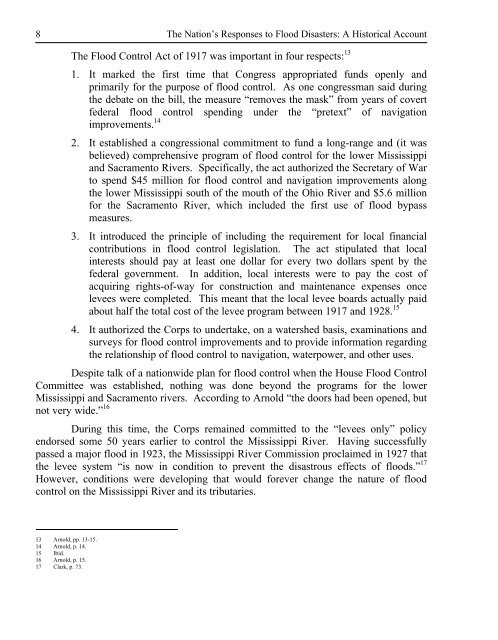The Nation's Responses To Flood Disasters: A Historical Account
The Nation's Responses To Flood Disasters: A Historical Account
The Nation's Responses To Flood Disasters: A Historical Account
You also want an ePaper? Increase the reach of your titles
YUMPU automatically turns print PDFs into web optimized ePapers that Google loves.
8<br />
<strong>The</strong> Nation’s <strong>Responses</strong> to <strong>Flood</strong> <strong>Disasters</strong>: A <strong>Historical</strong> <strong>Account</strong><br />
<strong>The</strong> <strong>Flood</strong> Control Act of 1917 was important in four respects: 13<br />
1. It marked the first time that Congress appropriated funds openly and<br />
primarily for the purpose of flood control. As one congressman said during<br />
the debate on the bill, the measure “removes the mask” from years of covert<br />
federal flood control spending under the “pretext” of navigation<br />
improvements. 14<br />
2. It established a congressional commitment to fund a long-range and (it was<br />
believed) comprehensive program of flood control for the lower Mississippi<br />
and Sacramento Rivers. Specifically, the act authorized the Secretary of War<br />
to spend $45 million for flood control and navigation improvements along<br />
the lower Mississippi south of the mouth of the Ohio River and $5.6 million<br />
for the Sacramento River, which included the first use of flood bypass<br />
measures.<br />
3. It introduced the principle of including the requirement for local financial<br />
contributions in flood control legislation. <strong>The</strong> act stipulated that local<br />
interests should pay at least one dollar for every two dollars spent by the<br />
federal government. In addition, local interests were to pay the cost of<br />
acquiring rights-of-way for construction and maintenance expenses once<br />
levees were completed. This meant that the local levee boards actually paid<br />
about half the total cost of the levee program between 1917 and 1928. 15<br />
4. It authorized the Corps to undertake, on a watershed basis, examinations and<br />
surveys for flood control improvements and to provide information regarding<br />
the relationship of flood control to navigation, waterpower, and other uses.<br />
Despite talk of a nationwide plan for flood control when the House <strong>Flood</strong> Control<br />
Committee was established, nothing was done beyond the programs for the lower<br />
Mississippi and Sacramento rivers. According to Arnold “the doors had been opened, but<br />
not very wide.” 16<br />
During this time, the Corps remained committed to the “levees only” policy<br />
endorsed some 50 years earlier to control the Mississippi River. Having successfully<br />
passed a major flood in 1923, the Mississippi River Commission proclaimed in 1927 that<br />
the levee system “is now in condition to prevent the disastrous effects of floods.” 17<br />
However, conditions were developing that would forever change the nature of flood<br />
control on the Mississippi River and its tributaries.<br />
13 Arnold, pp. 13-15.<br />
14 Arnold, p. 14.<br />
15 Ibid.<br />
16 Arnold, p. 15.<br />
17 Clark, p. 73.
















